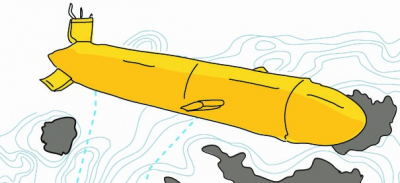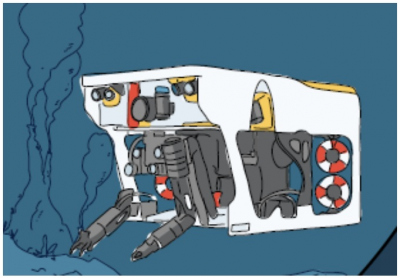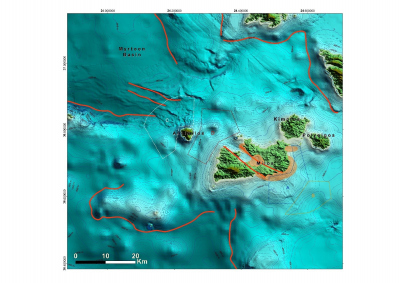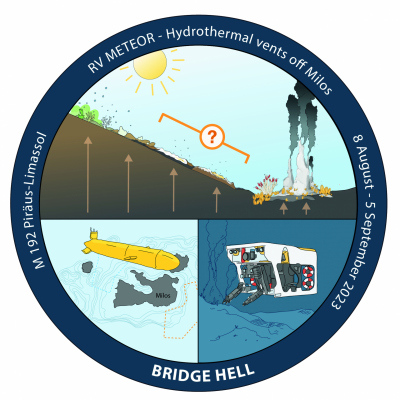This research cruise is a spin-off project of the DFG Emmy Noether Group Hydrothermal Geomicrobiology (led by the chief scientist S.I. Bühring), which focused on the study of the shallow water hydrothermal system off Milos. The reduced hydrothermal fluids from the Earth's interior and the oxidized seawater form a functional interface with diverse ecological niches for microoganisms, whose prevailing extreme conditions also demand diverse adaptive mechanisms from the inhabitants. We will study the geology, geochemistry and microbiology of hydrothermal systems along a transect from shallow, nearshore, photic to the deep, offshore, aphotic zone. This will be done along the Hellenic Arc, a subduction zone with known hydrothermal activity. The Aegean offers ideal conditions to study submarine hydrothermal activity in the transition between shallow and deep water, as well as the influence of water depth on biological processes and diversity. We intend to document the changes in fluids chemistry and associated microbial diversity and function with increasing depth and distance from land, and to investigate the relative importance of chemosynthesis and the dependence of animals on symbiotic associations with microorganisms with increasing depth.
- Home
- Solveig Bühring
- METEOR 192
METEOR 192
METEOR expedition M 192-1/2
Pireus (Greece) - Limassol (Cypris)
08.08.23 - 05.09.23
Contact /Chief Scientist: Solveig I. Bühring
Co-Chiefs: Andrea Koschinsky and Wolfgang Bach
Weekly Reports
Dashed polygons indicate planned working areas off the Greek island of Milos for METEOR cruises M192/1-192/2

Autonomous underwater vehicle MARUM SEAL

Remotely operated vehicle MARUM SQUID
Overview - expedition to Milos
|
To date, shallow-water and deep-sea hydrothermal systems have been treated as independent, seemingly unrelated entities; this expedition is a first foray into removing this arbitrary boundary and examining hydrothermal systems as a continuum. The planned work consists of 2 parts: (1) mapping hydrothermal seeps using the shipboard multibeam echo sounder, the AUV MARUM-SEAL 5000 and the CTD rosette water sampler, and (2) sampling (for geochemistry and (micro)biology) of hydrothermal vents and their plumes in a transect from shallow to deeper sites using a CTD rosette water sampler, in situ pums and ROV MARUM-SQUID.
|
Participating institutions:
MARUM Center for Marine Environmental Sciences, University of Bremen
Constructor University Bremen gGmbH, Department of Physics & Earth Sciences
Institute for Chemistry and Biology of the Marine Environment (ICBM), University of Oldenburg
GeoZentrum Nordbayern, Friedrich-Alexander-Universität Erlangen-Nürnberg (FAU)
National & Kapodistrian University of Athens, Department of Geology & Geoenvironment
Hellenic Centre for Marine Research, Institute of Marine Biology, Biotechnology and Aquaculture (IMBBC)
Max-Planck-Institut für Marine Mikrobiologie, Bremen
GEOMAR Helmholtz Centre for Ocean Research
Scientific program
|
The scientific program for M192 is divided into 5 areas: 1. mapping with multibeam echo sounder and AUV: Bathymetric mapping will provide essential information for a better understanding of the hydrothermal system off Milos. The ship's own Kongsberg EM 710 and the Parasound Subbottom Profiler will be used to produce a survey mapping. In addition, micro-bathymetry of selected areas of the seafloor will be established using the MARUM-SEAL 5000, an autonomous underwater vehicle (AUV) equipped with a multibeam and sidescan sonar system. AUV-based sidescan data are also capable of detecting gas flares in the water column, which can be used to precisely localize emission points on the seafloor. 2. Mapping of hydrothermal plumes: CTD (conductivity-temperature-depth)-measurements will be performed to create 2-dimensional geochemical maps of the hydrothermal plumes and analyse hydrothermal fluxes into the water column using the water sampler rosette. We will use sequential filtration to separate between particulate, colloidal, and dissolved phases to study biogeochemical transformation processes in the liquid-seawater mixing zone. 3. Geochemistry of hydrothermal fluids: Characterization of the fluids is critical to understanding fluid-rock interactions, circulation depth, and phase separation processes. The concentrated high-temperature fluids are sampled using isobaric fluid samplers (KIPS: multi-port valve-based Teflon fluid sampling system for use with an ROV system). These gas-tight samplers allow us to reliably determine dissolved gas concentrations, including CO2 and H2, which are critical for reconstructing pH and Eh conditions in situ. Furthermore, samples are collected for geochemistry of main and trace elements and dissolved organic carbon analysis. An on-line high temperature sensor operated by the ROV will be used to determine fluid temperature. 4. Geology and geochemistry of hydrothermal rocks: Sampling volcanic rocks in the different areas and hydrothermal precipitates at the vents with the ROV will provide information on the age and composition of the lavas that make up the hydrothermal vents. This will allow determination of the potential influence of magmatic volatiles and leaching of the rocks by fluids. The study of hydrothermal precipitates helps to determine the long-term evolution of the hydrothermal vents and possible changes in fluid chemistry over longer time periods. 5. Hydrothermal geomicrobiology along a depth gradient: To evaluate the changes in hydrothermal vents and their effects on geomicrobiology along a depth gradient, we plan to (a) collect fluid and pore water samples to study geochemistry, and (b) collect sediment samples and fauna. Gas-tight liquid samplers (KIPS) are used to collect aqueous fluids exiting hot vents. Ambient pressure corresponding to the sampling depth is maintained in the sampler after the ROV returns to the surface. Hydrothermal sediments will be sampled using ROV push cores, subsequently sliced horizontally. Samples will be collected and frozen for microbial community composition/functional analysis and microbial lipid adaptations. Pore waters will be extracted from ROV thrust cores and predrilled MUC cores using rhizones®. The ROV manipulator will collect samples of vent fauna that will be dissected and fixed onboard using various methods to study the diversity and abundance of chemosynthetic symbionts. |




